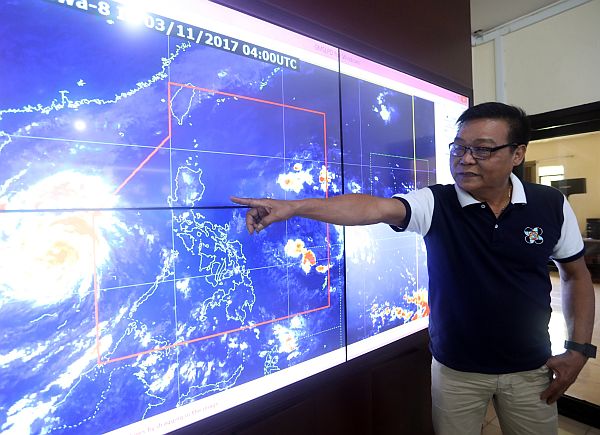
Engr. Oscar Tabada shows Pagasa’s new equipment. At far left, the Pagasa station in Mactan.
CDN Photos/Tonee Despojo
Even before it made landfall, the Mactan office of the state weather bureau Philippine Atmospheric, Geophysical and Astronomical Services Administration (Pagasa) already sensed that Super Typhoon “Yolanda” (international name Haiyan) will inflict massive devastation in the Visayas.
With heavy rainfall and winds packing in speeds of 185 to 235 km per hour (kph), Engineer Oscar Tabada, Pagasa Visayas chief, said their office was on high alert in the days leading to Yolanda’s entry into the Visayas on November 8, four years ago.
“We didn’t sleep during Yolanda. Every 30 minutes, we were sending details of the typhoon,” Tabada said in Cebuano.
When Yolanda passed through and damaged the Pagasa radar there, Tabada said their Mactan radar tracked and fed information on Yolanda’s movement.
Yolanda was the ninth tropical cyclone that made landfall and the 24th tropical cyclone that hit the country in 2013.
Landfall
It entered the country on November 7 and gained strength as it moved to Eastern Visayas.
It made its first landfall in Guian, Eastern Samar, at 4:40 a.m. on November 8 with wind speeds of 185 to 235 kph and traversed Leyte Gulf to make its second landfall in Tolosa, Leyte, at 7 a.m.
Yolanda then crossed and made landfall in Cebu, specifically Daanbantayan town, at 9:40 a.m.
It made another landfall on Bantayan Island after an hour.
Storm surges
Among the northern Cebu towns devastated by Yolanda were Bantayan, Borbon, Daanbantayan, Madridejos, Medellin, Pilar, Poro, San Francisco, San Remegio, Sta. Fe, Sogod, Tabogon, Tuburan, Tabuelan and Tudela. Also caught in Yolanda’s trail was Bogo City.
Storm surges, which people didn’t fully understand that time, flooded coastal areas in Visayas, most especially in Tacloban City and Basey, Samar.
When the skies cleared and the winds ceased to howl, more than 6,000 died in Yolanda’s wake while billions of pesos’ worth of property and infrastructure were destroyed.
Painful lessons
Despite their best efforts, Tabada admitted they fell short in helping the Filipinos in Eastern and Central Visayas be informed and prepared for Yolanda.
For starters, the Doppler Radar used by Pagasa was damaged by Yolanda. It was fully repaired only last year, Tabada said.
Tabada said the weather bureau was unable to explain to the public certain weather terms and phenomena like “storm surge” which local officials in Tacloban City found hard to explain to their constituents.
Looking back, Tabada said Yolanda gave a “lot of painful lessons” on how powerful and devastating the typhoons can get.
He said they now added Storm Signal No. 5 in their storm signal classification for typhoons packing maximum sustained winds of more than 220 kph.
Experience
Tabada said Pagasa is now more active in posting weather updates on their Facebook and Twitter pages while more detailed weather advisories are available on their official website.
Tabada said more Doppler Radars will be set up in areas like Tagbilaran, Bohol and Busuanga, Palawan, and they are expected to be completed next year.
The radars have an effective range of 200 km. Tabada also said they will translate technical terms in local languages so more people will understand.
Tabada said their office will also build its own data center similar to one in Manila.
“We really learned a lot from Yolanda. There really are times that if we don’t personally experience things, we won’t learn,” Tabada said.